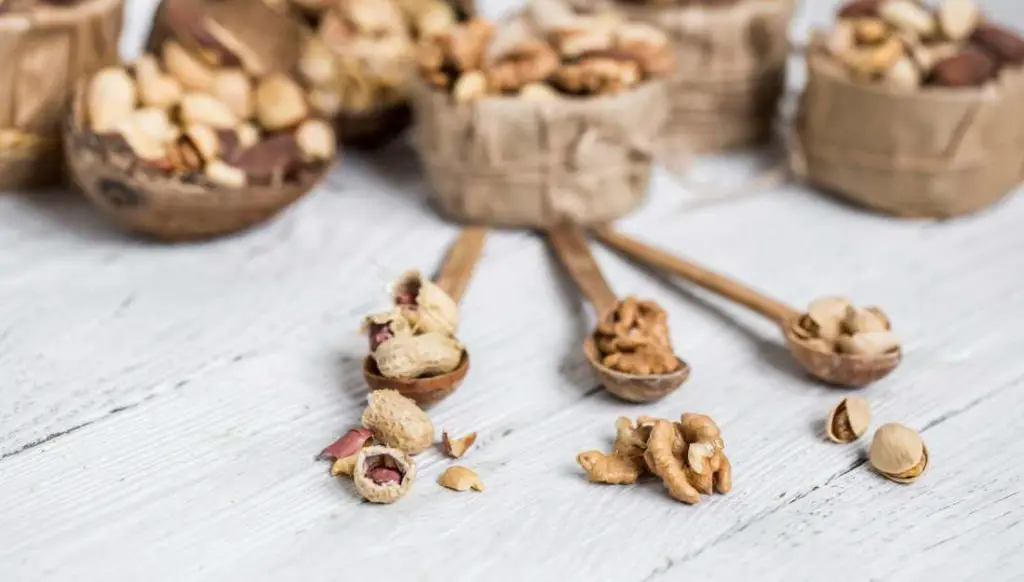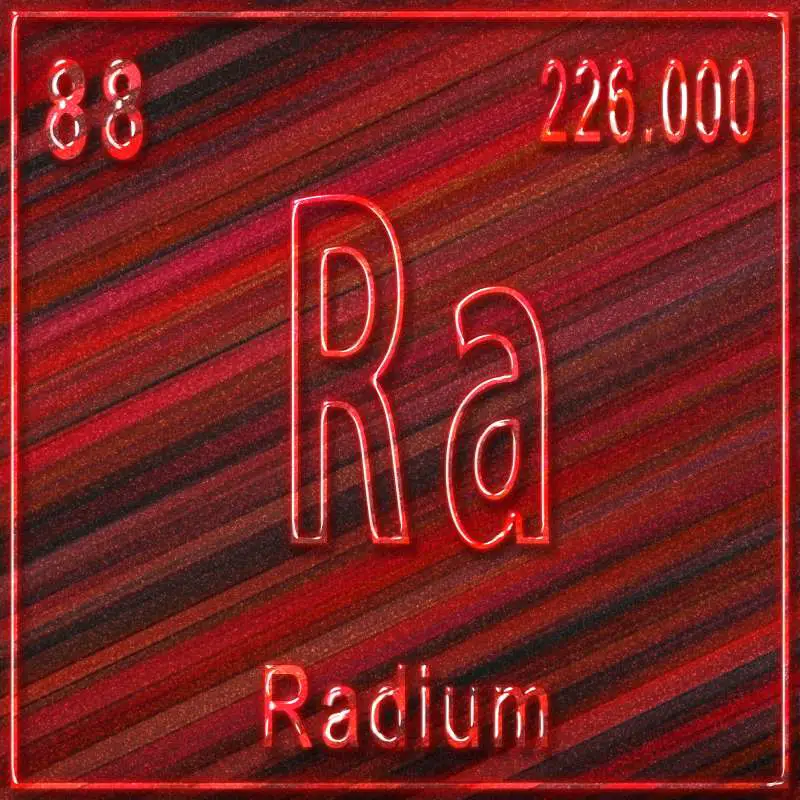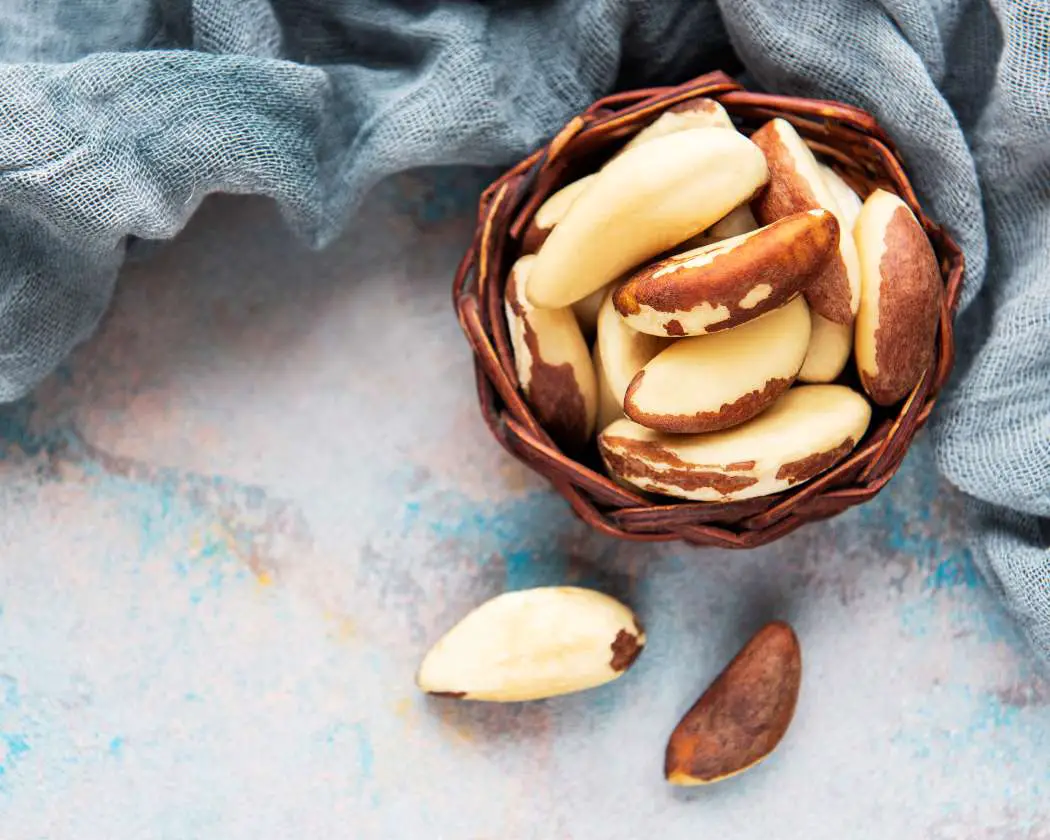Are Brazil nuts low histamine? If you have histamine intolerance, you might wonder what nuts are most and least likely to trigger histamine intolerance symptoms and which are safe to eat.
You might even wonder whether certain nuts are beneficial for histamine intolerance because of their anti-inflammatory properties. I covered the subject in a previous article on the histamine content of nuts and seeds but want to cover Brazil nuts in greater depth due to some of their distinctive properties.
In this article, you’ll learn more about the histamine content of Brazil nuts and whether the nut contains other components that affect histamine sensitivity symptoms. Let’s dig deeper into the question of whether Brazil nuts are high histamine and whether they’re safe to enjoy on a low-histamine diet.
What Are Brazil Nuts?
Brazil nuts are an edible tree nut that comes from a tree that grows in the South American rain forest. Mammoth in size, Brazil nut trees can reach 150 feet in height or taller. Even more shocking, they can have a lifespan of more than 500 years.
In terms of nutrients, the fruit of the tree, the Brazil nut, is nutrient dense, as are most nuts and seeds. The crunchy Brazl nut contains substantial quantities of calcium, potassium, and iron. (1) They’re also an excellent source of fiber with 10 grams of fiber in a cup of Brazil nuts. (1)
But what distinguishes Brazil nuts from other tree nuts is the amount of selenium they contain. What is selenium? It’s an antioxidant mineral that your body needs in trace amounts. Being an antioxidant, selenium may help reduce inflammation, as it protects against oxidative damage. It’s also used to make an enzyme called glutathione peroxidase, another free-radical fighting enzyme.
Selenium is a component of selenoproteins, (7) proteins that play a key role in health. Selenoproteins: (4)
- Participate in making thyroid hormone
- Assist in making DNA
- Important for reproduction
- Protect against cell damage
- Lower the risk of infection
Plus, selenium may be important for heart health, by reducing oxidation of LDL-cholesterol (the kind linked with cardiovascular disease) and may play a role in aging. (8)
Brazil nuts have one of the highest selenium contents of any food. The recommended daily intake of selenium is 55 micrograms daily and a single Brazil nut contains over twice that amount. Therefore, eating a single Brazil nut each day supplies double what your body needs on a given day.
Are Brazil Nuts Low Histamine?
Now to the subject of histamine. Brazil nuts are a low histamine food and aren’t known to be high in other biogenic amines. However, allergies to tree nuts, including Brazil nuts, is common.
Some, but not all, people allergic to Brazil nuts can tolerate them if they’re thoroughly heated or cooked. This breaks down certain proteins that trigger the allergic reaction.
Are Brazil nuts high histamine? f you have a Brazil nut allergy, avoid Brazil nuts and any other nut that you’re allergic. But in the absence of a Brazil nut allergy, Brazil nuts are not known to trigger histamine intolerance symptoms.

Brazil Nuts and Histamine Intolerance
Being a low histamine nut, eating Brazil nuts in moderation is unlikely to cause histamine intolerance symptoms and there’s evidence that the selenium in Brazil nuts could be of benefit if you suffer with histamine intolerance. Being an antioxidant, selenium may help reduce inflammation, as it protects against oxidative damage.
Getting enough dietary selenium may even be beneficial if you have histamine intolerance. A study from 2013 found that treating mast cells with selenium, histamine producers, led to a modest drop in the amount of histamine these cells released. That could be beneficial if you have allergies or histamine intolerance. (2)
At the very least, you should ensure you’re getting enough dietary selenium to support your antioxidant defense system and for healthy thyroid function. You need selenium for the production of thyroid hormone.
Downsides of Consuming Brazil Nuts
The lack of histamine in Brazil nuts is a positive but there are a few reasons to limit the number you consume. One is to avoid consuming TOO much selenium. The upper limit of selenium you can safely take in without ill effects is around 400 micrograms.
How many Brazil nuts per day is safe? Since a single Brazil nut can contain as much as 100 micrograms of selenium, eating a handful of Brazil nuts daily could lead to ill effects. Limit the number of Brazil nuts yo uconsume to 1-2 per day maximum. Signs of selenium excess include: (4)
- Hair loss
- Brittle fingernails and toenails
- Nausea
- Fatigue
- Tender muscles
- Skin flushing
- Diarrhea
- Mood Changes
Brazil nuts also contain modest amounts of radium, a radioactive material. Radium comes from the soil, but the roots of Brazil nuts trees concentrate the radium. It can reach levels up to 1,000 times higher than in other common foods. (3)
Why should you be concerned about radium? Radium is a radioactive element found in soil, rocks, and water. Because foods grow in soil, they can absorb some radium. Most foods don’t contain enough radium to pose a problem.
Whether radium causes problems depends upon the totality of your diet and how much exposure you get from the environment and the water you drink. But consuming large quantities of radium increases the risk of cancer and other health problems including cataracts, fractured teeth, and anemia. (6)

While the U.S. government has set “safe” levels for radium and other radioactive elements, there are no safe levels for cancer risk. Even if the levels of radium in your food or water are below the legal limit, you might still have an increased risk of cancer since other factors may boost your risk such such as family history, lifestyle, and exposure to other chemicals.
The average person’s risk of getting cancer from radium in his or her foods is small, but it is not zero. The risk depends on how much radium-containing food and water you eat and drink, age, genetics, and other factors. Brazil nuts happen to be one of the foods highest in radium.
Are Brazil Nuts High in Histamine? Not but Don’t Overdo It
Brazil nuts are low in histamine and an excellent source of selenium, a tract mineral that may be beneficial if you have histamine intolerance. But, as mentioned, you can get too much selenium if you eat more than one or two Brazil nuts per day.
The radium in Brazil nuts is another concern and another reason not to make Brazil nuts your go-to snack. That’s why it’s best to limit Brazil nuts to one per day. Eating just one Brazil nut a day is enough to supply your body with the selenium is needs. Plus, if you’ve ever eaten one, you know how satisfying this tree nut can be.
In conclusion, Brazil nuts are considered low histamine and are generally safe for individuals with histamine intolerance. However, be mindful of their selenium content and limit your consumption to avoid excessive selenium intake.
As with any dietary changes, it’s advisable to seek guidance from a healthcare professional to ensure that your choices align with your individual health requirements.
Keep a Food Journal if You Histamine Intolerance
Everyone with histamine intolerance is a little different. If you add a few Brazil nuts to your diet, track your response by keeping a food journal. A food journal allows you to keep close tabs on your symptoms and their relation to the foods you eat.
A food journal helps you determine which foods are causing problems and make your histamine levels spike. It’s one of the most important things you can do if you have histamine intolerance, whether you eat Brazil nuts or any other food.
Be aware of what you eat, read labels, and understand how your body responds to the foods you put on your plate and the beverages you drink, especially if you have histamine intolerance.
References:
- NutritionalValue.org. “Brazil Nuts” https://www.nutritionvalue.org/Brazil_nuts_42102000_nutritional_value.html
- Safaralizadeh R, Nourizadeh M, Zare A, Kardar GA, Pourpak Z. Influence of selenium on mast cell mediator release. Biol Trace Elem Res. 2013;154(2):299-303. doi:10.1007/s12011-013-9712-x.
- Concentrations of selenium, barium, and radium in Brazil nuts. June 2008Journal of Food Composition and Analysis 21(4):332-335. DOI:10.1016/j.jfca.2007.12.001.
- “Selenium | The Nutrition Source | Harvard T.H. Chan School ….” https://www.hsph.harvard.edu/nutritionsource/selenium/.
- “Selenium – Health Professional Fact Sheet.” https://ods.od.nih.gov/factsheets/selenium-healthprofessional/.
- “Radium | Public Health Statement | ATSDR.” https://wwwn.cdc.gov/TSP/PHS/PHS.aspx?phsid=789&toxid=154.
- Labunskyy VM, Hatfield DL, Gladyshev VN. Selenoproteins: molecular pathways and physiological roles. Physiol Rev. 2014 Jul;94(3):739-77. doi: 10.1152/physrev.00039.2013. PMID: 24987004; PMCID: PMC4101630.
- “Selenium levels and glutathione peroxidase activity in ….” https://www.ncbi.nlm.nih.gov/pmc/articles/PMC7881534/.

